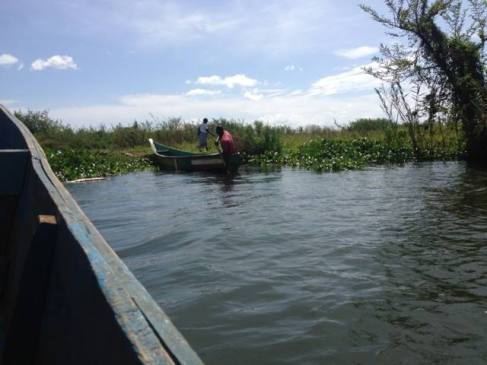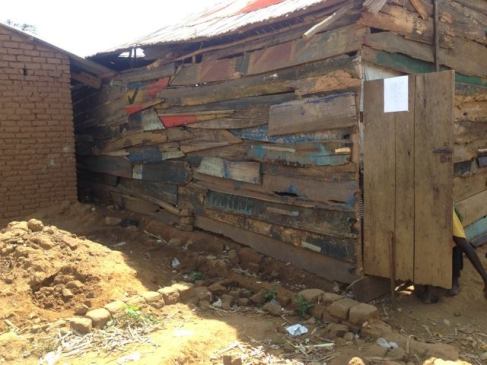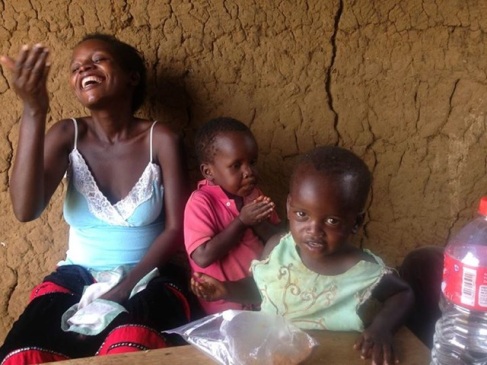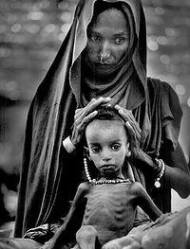Water for the people of Kisima Island
December 11, 2013 at 8:01am, by John Eckhart
In November of 2013, I travelled to Jinja, Uganda to work with International Medical Relief providing healthcare to people with no access to care whatsoever. Twenty five of us on the team and during the week we were there we treated over 2,000 people.
After a long hard day of clinic in the Luwuka District of Uganda, I was enjoying coffee with Jean Kaye and Ally Novell after the rest of the team had gone to bed. Jean was the team leader for this mission and Ally was working closely with her. Ally was expressing her deep frustration over the phone calls she had been receiving from Pastor Kijambogo Mukisa Franco who lived on Kisiama Island out in the middle of Victoria lake. The water well that supplied water for the 1500 inhabitants of Kisima island had been out of service for seven long years. They had a small rainwater collection system, gutters that collected water from a small galvanized roof that lead to a six foot concrete tank. this kept them going except it had not rained there in a long time. The people of the island were drinking water from the lake. His people were getting sick, further deepening the problem was the latrine that the people used was completely full so that they could no longer use it. Many people on this island were sick or getting sick and their situation getting very desperate. Ally had no idea what to do for this man or his people.
Listening to Ally, I realized that I could fix their well. I have owned property in Idaho with several wells on it for the last 35 years. Whenever these well pumps had problems, I could never afford to pay someone to fix them so I had to educate myself about the pumps and fix them myself.
I told Ally and Jean that I thought that I could fix that well pump. Although this was out of the scope of what International Medical Relief usually does, they agreed to send me to the island with the natives but could not send any other team members with me. I would be missing a day of clinic with the team but if there was a chance that I could provide for this community a clean source of potable water it would be for the greater good. To prevent Illness rather than treat it.
Two years ago, I was a very sad man. I felt that my life had no meaning and I wanted it to change. a dear friend introduced me to Amy Jordheim and I got involved with International Medical Relief. I took a trip to Ethiopia six months ago that forever changed my outlook and my life. When I signed on for the effort in Uganda and began fundraising, I told most everyone that doing this work, for me, was like I was dying of thirst and had been given the job passing out water. I will say that again: “I was dying of thirst and had been given the job passing out water”.
When I arrived in Uganda, Jean had no idea that I had been using “passing out water” as a metaphor for how my own life had changed. the first interaction that I had with her, Jean gave me the job to see to it that the team had… water. It would be my responsibility to see to it that there was an adequate water supply on the bus for team before each day of clinic and ironically, the room I stayed in while in Jinja Uganda was right off of the supply room/kitchen so every night and every morning I would lift the heavy water jugs to fill the water bottles for every member of the team.
The following day as we were traveling to a small village near the border of Kenya I was reflecting on the people of Kisima island, their well, their need. Would I be able to fix their well? would I go there and fail? It was then that I remembered what I had said to so many, “I was dying of thirst and got the job passing out water”. I realized that I had been doing that very thing the entire time I had been in Uganda to that point and that I now had the opportunity to give a sustainable source of water to an entire community. I was so grateful at the thought of it that I wept.
The next day as the team prepared for another day of clinic, I loaded the water on the bus and then prepared for my own journey. We were working in a third world country, Ally and Jean who had spent a lot of time in Jinja with their work for Help International and the Help School in Masese both told me that the village on Kisima was the poorest place they had ever seen and that I needed to prepare myself for what I would see there.
After the rest of the team had departed, Ally and I travelled to the fishing village in Masese, but the boat for my passage had not yet arrived so we then travelled to Jinja to obtain the tools I would need to work on the pump. There were no tools at all on the island and none to be had in Masese. I had time to consider what my minimum needs would be for this job even though I had no idea what this pump even looked like and we were able to acquire everything with little difficulty. Ally “haggled” with the merchant as though she had been doing it her whole life. the tools were all placed in a cardboard box and we headed back to the fishing village.
There were many boats at the fishing village but none of them would be anything close to what you would consider modern. Hand hewn wooden planks of mahogany, sealed with pitch with tin nailed over the seams. the boats all had exaggerated bows to cut through the swells of Victoria lake, one of the largest freshwater lakes in the world that I imagine could have swells like that on the ocean.
The boat would twist and flex with each swell and the spray covered us as we headed towards the Island. There were several nuns on board, one a teacher, the other, a nurse. We stopped at the sister Island, Kisima 2 and dropped one of the nuns off there. she climbed over the the bow of the boat and disappeared into the brush. There was a fisherman there wearing a shirt so tattered I wonder why he even bothered to put it on. Clearly it was the only shirt this man had. Pastor Franco told me there were 600 children that lived on Kisima2 but that there were no quarters for the teachers so they would come by boat every day.
We then set off for the Kisima, when we arrived, there was a woman quietly turning very small silverfish over in the sun. they were spread out on a 30 ft fine net in the sun to dry. The shore was lined with hand hewn fishing boats, several women were there filling large yellow jugs with Lake water.
Pastor Franco, showed me his home, a very small mud structure with a tin roof. He then showed me his church. a ten by twelve foot building made from salvaged boat hulls.
I met the pastors wife, Margret, his children, Mukisa Joel and Mwesigwa James, both were sick.
As the pastor showed me around the island, children followed us, most wearing rags, some with the distended bellies of malnutrition. In Africa, white people are known as “Mzungu”. We’re viewed as saviors, caretakers and to many children, we’re ghosts. they are are once fearful of ..and drawn to the Mzungu.
He showed me the failed latrine, long since abandoned, the stalls filled with refuse, the fiberglass panels of the roof that had been installed for light had rotted through. The steel lids covering the holding tank accesses were rusted through. The Pastor told me that the stench from this latrine had become so unbearable with it filled up and that they had filled them as much as they could with ash to try and deal with the stench.
I asked him, “pastor, where do your people go to relieve themselves?” He just shrugged and said, “the nearest bush”.
Before I journeyed to Ambo Ethiopia with IMR earlier this year, I was encouraged to read the book, “Where there is no doctor”. I studied that book. The people Of Kisima Island and how they lived mirrored those in that book to the letter. The lack of clean water, the lack of sanitation, how necessary it was for the people to dig latrines, but more than that, how these people did not understand why it was that they were all getting sick.
Pastor Franco showed me the well pump. It had a goat tied to it. It obviously had not produced water in a very long time. the pastor introduced me to the elders of his tribe, those responsible for the well, the latrine and the boats as well as other men from the community. With the Pastors help as interpreter, I told them all that I wanted them to help me dismantle the pump so that we, as a group, could determine why it was not working. I told them that I wanted all of them to understand how the pumped worked, how it was able to pick water up from deep in the ground and that if they understood it, then they would be able to fix the pump themselves in the future.
We began taking the pump apart and I found that it was packed with debris. The lift chain rusted and seized, the lift rod was bent. We removed the well head and the attached pump handle, then working the lift rod up and down until it was free and working together we pulled its thirty foot length from the well riser. the foot valve at the bottom was completely fouled with rust and scale.
I showed the men there how the foot valve worked, that it would open when the handle was lifted pushing the valve deeper into the well and that it would close when the handle was pushed down thereby lifting the water in the riser.
I showed them that the rust and scale would fall off of the pump rod and that if it fouled the valve it would no longer seal and the pump would no longer lift the water. they could then see how important it was for everything to be clean so we all scraped the rust and scale from every inch of the pumprod and footvalve. then I showed them that the small watertank at the head of the well and the water spout were both completely packed with rust, scale and sediment, so much so that no water could get though it at all. I told them everything would have to be cleaned and rinsed out but that it was very important that the well head be sealed to prevent anything from getting down in the well that might contaminate it. I asked the pastor for an old spoon that I could use to dig the rust and scale out. One of the men fetched a fork and I said that it would work if I just put a bend in it, Pastor Franco snapped it out of my hand and said, “No. please don’t ruin the fork, he will go and get you the spoon you requested” This fork was one of those cheap stamped aluminum ones you might find in an army mess kit. Yet it was so valuable to him. I was having trouble cleaning the spout and I needed a short piece of wire, I asked the pastor if he had an old coat hanger. I have improvised with old wire coat hangers in my life more times than I can count. when the man came with the coat hanger it was one that had been home made, fashioned from a piece of wire and I quickly cut it up without thinking that this was the only thing this man had to hang his coat on, later on, I felt terrible about it. I live in such abundance that I do things without thinking. I did get the spout clean. Then I had them fetch jugs of water from the lake and with the well head tightly sealed with a rag, we rinsed everything off.
Working together
Then together we assembled the well pump. Once we were done, the Pastor himself began to pump the handle. Cheers of joy erupted as the water began to gush from the spout. They were so excited, each of them taking turns pumping the water. We placed a pan under the spout and I showed them that each time they filled it, the water would be cleaner than the time before, the rust would clear quickly.
Even the children wanted turns at the handle. It is written, “With joy we draw water from the wells of salvation” Dying of thirst, drawing water for these whose thirst was now over. the joy as pure as the water coming out of the ground. Water is the foundation of life and these wonderful people now had a clean sustainable source.
The pastor said that he wanted to honor me with a meal with his people, so we went to a special hut by the water, small handmade tables were brought in, and a pan with a jug of water to wash our hands. Margret bought in Talapia, Victoria lake perch and lion fish she had prepared as well as a potato like banana. The meal was delicious!
I had some homemade oatmeal cookies with me that my daughter in law Janine Eckhart had baked. ( I must confess here that cookies do not fare very well being carried in a pack halfway around the globe so I lovingly referred to these as Janine’s Homemade Oatmeal Uganda Cookie Crush) I asked Pastor Franco and the tribal elders if they would like to share them with me. they were very hesitant at first but lit up as they each tasted them.
Pastor Franco asked if his wife Margret could try them and he sent for her. She was even more hesitant than the men. Margret doesn’t know if she wants to try this or not.
(I love the twinkle in her eye here as she tastes this)
After trying Janine’s cookies, Margret called for her children to share them them with us as well.
She was laughing with joy that moment when I snapped a photo of her and her children in that little hut by Victoria Lake. Of the 1400 pictures I took on this trip, this was the defining moment, The best photo of them all, this mother rejoicing over clean water for her children and janines home baked oatmeal cookies.
It is the best photo for me because I felt that I had come full circle. You see, I had been living with this photo posted in my home of an Ethiopian woman and her child who had fled to Somalia during the famine in the early 1980s
This photo haunted me for years. It looks somehow to me like the Madonna and the Christ child. The baby’s eyes are so piercing and the anguish on her face, the mother who would give anything for food for her child if only there was food to be had. I swore to myself that one day I would help. Who could have known that one day I would bring Joy, laughter, fresh water and *cookies* to this mother of sick children on the other side of the globe?
We really can make a difference, you know?
After dessert I settled in with the men from the village and and with Pastor Franco interpreting for me I explained Sodis to them, that if they did not have clean water, they could fill plastic water bottles with lake water and place them in the sun from morning to evening and the water would be fit for them to drink. I explained to them how the sun wold purify the water for them and that if they kept enough water bottles so that they could have a set up on the roof while they were drinking the other they would never run out of water that would not make them sick.
I explained to the men how the germs from the feces of their people could not help but be tracked back into their village by their people, children and animals because they were just leaving it on the ground. the feces were coming into the homes and getting into everything. I explained to them that this was what was contaminating their water and making their people sick. I explained to them how they needed to dig a latrine, that it did not have to be a big hole, just big enough to go in and that they could build a small tent over it, one they could easily move when the hole got full. I explained how important it was that the hole be filled with dirt before they moved the tent so that it was covered and nothing could get into it. I explained to them that if they followed what I taught them that their people would get well and there would not be nearly as much sickness in their village as there had been.
We said goodbye to one another, I said goodbye to the children and climbed aboard that rickety boat and headed back to the mainland.
There are no words to express my gratitude to International Medical Relief for the opportunity…. the gift really, of serving these wonderful people. There are no words to express my gratitude to all my dear friends who helped me to do this work. I took all of you with me to this wonderful place. I was asked for a special story, some singular event that was meaningful, (I apologize for the length of this ) a way that I was touched by a person or a patient in Clinic. That is difficult for me because I have been touched in every single way and profoundly so, by the entire experience. The juxtaposition of moving from the great wealth of the United States through the grueling international travel to the crushing poverty of the third world to have a malnourished, sick child take you by the hand in love, reveals in us all ….our own humanity.
–John Eckhart













